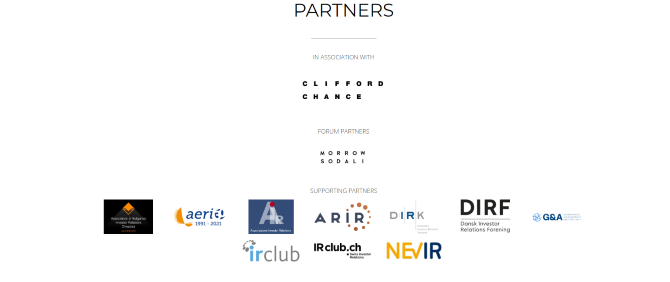This November, IR professionals, sustainability experts, governance professionals and other members of the investment community gathered to discuss how ESG priorities are changing at the ESG Integration Forum – Autumn in London.
As might be expected at the end of a year as eventful as 2023, attendees had a lot to talk about. The forum took place less than six months after the International Sustainability Standards Board launched its two global sustainability reporting standards (IFRS S1 and IFRS S2), two months after the Taskforce on Nature-related Financial Disclosures dropped its biodiversity framework and just over a month before the Corporate Sustainability Reporting Directive comes into effect throughout the European Union.
And as a plethora of new acronyms have now been added to the ESG lexicon, one of the event’s sessions looked at how companies can align metrics and indicators with the most relevant frameworks and rating agencies.

How to best engage with rating agencies? How credible are they? Here, we’ve gathered takeaways and talking points from one of the event’s sessions, entitled ‘Ratings agencies and reporting frameworks: Understanding the Venn diagram of disclosure requirements’.
‘A call for action’
A Venn diagram serves as an illustrative tool employing overlapping circles to depict connections between specific elements. Within the realm of disclosure requirements, it represents how companies are reporting ESG information as requested by various rating agencies.
But these agencies, operating in distinct regions, employ different criteria. Simultaneously, companies must cater to the expectations of investors, regulators and other stakeholders. This dynamic can lead to discrepancies due to the varied methodologies used by such agencies, raising concerns about reliability, transparency and potential conflicts of interest.
Punam Mehta, assistant general counsel at Mercer and a speaker at the forum, said there was a lot of divergence within the industry in terms of reliability of companies’ ratings.
‘ESG rating providers are definitely in the spotlight,’ she said. ‘For example, regulators globally are starting to look at ESG rating providers and sending document requests to see what their methodologies consist of.’

Mehta also noted transparency and conflicts of interest as two other issues. On the latter, she said a conflict could be an ESG rating provider rating an organization and then offering competing services to help that same firm get better ratings next time.
She added that this is different from consultancies providing ESG rating tools as part of their services (such as benchmarking) and that such consultancies are not in the same category as the ESG rating providers that are of concern to regulators. ‘As a result, there is a call for action to try to regulate ESG ratings providers and combat some of the greenwashing issues that are emerging,’ she noted.
Enrico Filippi, ESG and planning director at Technogym and another panelist at the forum, shared concerns about standardization and relevance in rating methodologies. He emphasized the challenge of aligning diverse businesses under generic ratings frameworks, urging a shift toward tailored assessments reflecting a company’s unique operations, while also stressing the importance of engaging with rating agencies.
‘A lot of rating agencies try to set up a general framework of KPIs that can potentially be used to monitor any company in the world in any sector,’ Filippi said.

‘This means that if you are a major oil company or a car maker, it could make things easier, because you have the chance to be compared with all the other companies working in the same field.’
But he added that for a company like Technogym, which operates in a ‘niche sector’, comparison can be problematic because the KPIs don’t always reflect the nature of its specific business.
‘This is, in my opinion, something that should be changed,’ Filippi said. ‘Having engagement is fundamental for companies and rating agencies, as it has always been for financial analysis. I hope that in the future – thanks to increased regulations and new competitors in the field like investment banks – rating agencies will make it easier for an issuer to speak with them to try to assess their parameters.’
‘Know the language your audience is speaking’
Further discussing the issue at the event, Eva Pekárková, stakeholder dialogue expert at Prague-headquartered ČEZ Group, emphasized the critical nature of effective communication with rating agencies.
Sharing some background, she explained that rating is the main responsibility of her role. And while her job title can lead one to think she engages primarily with stakeholders, she says the dialogues she has are ‘almost exclusively with rating providers’.

Pekárková noted that when the ESG office was established at ČEZ Group two years ago, the company realized that despite its thorough reporting, language barriers and inconsistencies led to limited scores in critical areas within the rating report. This was because the report was in Czech and evaluated by an international rating agency. The lesson? Language matters to bridge information gaps and ensure accurate assessments.
‘If there is one takeaway today it’s that you need to know the language your audience is speaking, because if you don’t speak that language, your message is never going to get across. And you will still have gaps,’ Pekárková said.
Remember what disclosure is for
Panelists acknowledged the evolving regulatory landscape’s impact on ESG reporting, foreseeing potential benefits in closing the ESG data gap. But cautionary notes were raised against a superficial approach to reporting solely for ratings, stressing the importance of genuine internal alignment with a company’s core strategies.
‘We’re producing and disclosing information for reporting requirements to meet regulatory obligations,’ Mehta said. ‘It’s not for the sole purpose of getting a good ESG rating. And I think there’s a risk that if companies approach reporting by specifically thinking about what their ESG rating will look like, they’ll start to do a data dump in their disclosure reports and annual reports, or just look at it as more of a tick-box exercise – which is not the intention.’
In conclusion, the panel echoed the sentiment that while ESG rating agencies play a pivotal role in assessing sustainability performance, they shouldn’t be the sole guiding force. Companies need to focus on genuine alignment with their vision, strategy and transparent reporting, viewing ratings as indicators rather than decisive factors. Transparency, genuine engagement and strategic focus emerged as pivotal factors for companies navigating the complex ESG landscape.
‘Rating agencies cannot be the North Star for any of you,’ said Filippi. ‘[They simply offer] a way to understand whether or not you are speaking the correct language and whether or not your message is understood. Rating agencies [should be seen as providing] support or maybe some incentives to support a faster development of your company’s projects.
‘The company must set up its strategy and ESG targets, [taking into consideration] what its DNA is, its vision, its mission on the back of that. I really think that sooner or later ESG rating agencies and everyone else will understand what you are doing and what your goals are.’
For more information about the ESG Integration Forum – Autumn, please click here.











